Earlier this summer I attended a conference on pain.
Why, you may ask, are you attending a conference on pain?
Because the vast majority of clients walk in my door with some kind of pain.
Now I am (obviously) not a pain scientist. But developing an understanding of how pain occurs, I figure, goes hand in hand with my work as a massage therapist.
Again, why?
Because pain is very often NOT accompanied by tissue damage.
Pain is often the bodies way of saying “stop that movement” or “be careful”. Think here of low back pain.

Yes, there can be physical damage that causes low back pain – structural problems such as disc issues, stenosis or spondylosis can clearly cause nerve irritation and pain.
But just as frequently, more benign situations such as lack of movement (think sitting or driving for long periods of time) cause pain. These typically don’t involve structural problems, why is there pain?
And what if I also told you that stress, lack of sleep, lack of friends, your cultural background, mood can all affect your sensitivity to and perception of pain.
Enter the biopsychosocial model of pain. There are many factors that can affect the perception of pain, including:
- Biological – genetics, inflammation, nerves detecting painful stimuli, system dysfunction, tissue pathology
- Psychological – beliefs, thoughts, knowledge, emotions, feelings, actions
- Social – family, friends, colleagues, access to care, community, culture, society
Turns out what affects your perception of pain in any given circumstance is very complex.
Let’s take a look at two classic case studies to illustrate the many factors affecting an individual’s perception of pain.
A construction worker steps on a board with a nail sticking up. The nail goes through his boot and sticks out of the top of the boot. He is in immediate pain, gets assistance and heads for medical assistance. When they cut open his boot to remove the nail, they see that the nail (somehow) just went between his toes and did not damage any tissue.
He clearly experienced intense pain. But why? There was no tissue damage… The worker saw the nail puncture his boot and (I assume) his mind registered clear danger and potential harm. Perhaps he was scared, or had seen this happen to other co-workers.
The second case study is another construction scenario. A worker is using a pneumatic nail gun. The nail gun misfires. He’s curious about what happened, but ensures the gun is working and moves on and continues working. Days later he is at a routine medical appointment. An x-ray shows that he has a nail in his skull. The nail gun backfired and shot the nail in the opposite direction… yet he never felt any pain. Perhaps he felt no pain because he had no visible indication of a problem?
Two very different reactions, yes? The case studies illustrate the range of “pain reactions” that can occur due to the many factors identified in the biopsychosocial model of pain.

Understanding that there are many factors that influence the perception of pain (and that pain in many cases is not caused by tissue damage) can be the first step to feeling some hope, opportunity or control in the face of pain.
Moving towards, or exploring pain in a gradual way can advance a sense of control even further. By exploring I mean a gradual or “graded exposure” to reassure oneself that some amount of discomfort can be tolerated.
From a treatment standpoint, graded exposure opens the door for incremental improvements in movement. This in turn creates a positive feedback loop that movement can happen and can be tolerated.
I have seen this in a number of clients over the past year. Where either massage and/or a controlled exercise program can initially illuminate the possibility of improving movement with only minor discomfort. This window creates more confidence and in turn, more movement with less pain.
But it all starts with an exploration of the factors that influence the experience of pain. A fantastic book on this topic is Explain Pain. You are welcome to flip through my copy or borrow it for a couple weeks. There are also great resources at www.painrevolution.org.
I will have more on pain and opportunities for movement in future blogs. Stay tuned!

